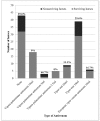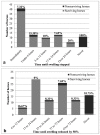Daboia (Vipera) palaestinae Envenomation in 123 Horses: Treatment and Efficacy of Antivenom Administration
- PMID: 30893807
- PMCID: PMC6468471
- DOI: 10.3390/toxins11030168
Daboia (Vipera) palaestinae Envenomation in 123 Horses: Treatment and Efficacy of Antivenom Administration
Abstract
Envenomation by venomous snakes is life threatening for horses. However, the efficacy of available treatments for this occurrence, in horses, has not yet been adequately determined. The aim of this study was to describe the treatments provided in cases of Daboia palaestinae envenomation in horses and to evaluate the safety and efficacy of antivenom administration. Data regarding 123 equine snakebite cases were collected over four years from 25 veterinarians. The majority of horses were treated with procaine-penicillin (92.7%), non-steroidal anti-inflammatory drugs (82.3%), dexamethasone (81.4%), tetanus toxoid (91.1%) and antivenom (65.3%). The time interval between treatment and either cessation or 50% reduction of local swelling was linearly associated with case fatality (p < 0.001). The overall mortality rate was 20.3%. Treatment with procaine-penicillin was significantly associated with reduced mortality (OR = 0.11). Three horse-derived antivenom products were available during the study period, of which the horses were administered different brands of varying dosages. Administration of the recommended dosage of any of the aforementioned products led to a significant decrease in mortality (p = 0.014), even in severe cases (scoring 2 or greater on the equine snakebite severity scale). No adverse reactions were reported. The results of this study show that species-specific D. palaestinae antivenom administered at the manufacturer-recommended dosage is effective in significantly reducing mortality in cases of envenomation in horses.
Keywords: Daboia palaestinae; Vipera palaestinae; antivenom; envenomation; horse; snakebite.
Conflict of interest statement
The authors declare no conflict of interest.
Figures




Similar articles
-
Daboia (Vipera) palaestinae envenomation in horses: Clinical and hematological signs, risk factors for mortality and construction of a novel severity scoring system.Toxicon. 2017 Oct;137:58-64. doi: 10.1016/j.toxicon.2017.07.007. Epub 2017 Jul 8. Toxicon. 2017. PMID: 28698056
-
Suspected envenomation by the common European adder (Vipera berus berus) in 28 horses in Finland.J Equine Vet Sci. 2024 Sep;140:105145. doi: 10.1016/j.jevs.2024.105145. Epub 2024 Jul 1. J Equine Vet Sci. 2024. PMID: 38960009
-
Evaluation of antivenom therapy for Vipera palaestinae bites in children: experience of two large, tertiary care pediatric hospitals.Clin Toxicol (Phila). 2017 Apr;55(4):235-240. doi: 10.1080/15563650.2016.1277233. Epub 2017 Jan 20. Clin Toxicol (Phila). 2017. PMID: 28103732
-
A Guide to the Clinical Management of Vipera Snakebite in Italy.Toxins (Basel). 2024 May 31;16(6):255. doi: 10.3390/toxins16060255. Toxins (Basel). 2024. PMID: 38922149 Free PMC article. Review.
-
Vipers of Major clinical relevance in Europe: Taxonomy, venom composition, toxicology and clinical management of human bites.Toxicology. 2021 Apr 15;453:152724. doi: 10.1016/j.tox.2021.152724. Epub 2021 Feb 18. Toxicology. 2021. PMID: 33610611 Review.
Cited by
-
A dose scaling antivenin protocol in treatment of Daboia palaestinae envenomation may reduce morbidity and costs.PLoS One. 2025 Jun 26;20(6):e0319119. doi: 10.1371/journal.pone.0319119. eCollection 2025. PLoS One. 2025. PMID: 40569962 Free PMC article.
-
The Middle Eastern Cousin: Comparative Venomics of Daboia palaestinae and Daboia russelii.Toxins (Basel). 2022 Oct 23;14(11):725. doi: 10.3390/toxins14110725. Toxins (Basel). 2022. PMID: 36355975 Free PMC article.
-
Design, development and preclinical assessment of MENAVip-ICP, a new snake antivenom with potential coverage of species in the Middle East and North Africa regions.Toxicon X. 2024 Aug 30;24:100206. doi: 10.1016/j.toxcx.2024.100206. eCollection 2024 Dec. Toxicon X. 2024. PMID: 39290878 Free PMC article.
References
-
- Bruchim Y. Viper Snakebites. Isr. J. Vet. Med. 2010;65:39–41.
-
- Kochva E. Venomous snakes of Israel: Ecology and snakebite. Public Health Rev. 1998;26:209–232. - PubMed
MeSH terms
Substances
LinkOut - more resources
Full Text Sources

